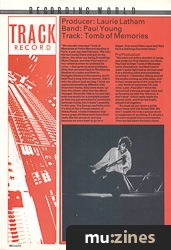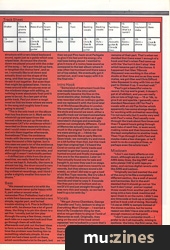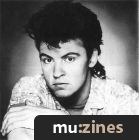Magazine Archive
Home -> Magazines -> Issues -> Articles in this issue -> View
Article Group: | |
Track Record - Tomb of Memories | |
Paul YoungArticle from International Musician & Recording World, September 1985 | |
Paul Young's Tomb Of Memories analysed track by track

Producer: Laurie Latham
Band: Paul Young
Track: Tomb of Memories
"We actually recorded Tomb of Memories at Pathe Marconi studios in Paris, a year ago last February. We only did two tracks there that got on the album, the other one being Everything Must Change, and then Paul went on tour which is when he strained his voice — that gave us some problems. After that we went back to Workhouse Studios in London and then to Parkgate Studios in the country, but it took Paul a long time to recover, that's why the album took so long. I think we captured something different with those two tracks, they were more 'up' than the others; after that the album changed. Normally I like to try and stay with one studio for a complete project so that you get some kind of continuity between tracks, but it wasn't possible in this case. The Stones use Pathe a lot, it's kind of like a French version of Abbey Road. I chose it because they have a great old Neve desk there that I really like the sound of, and also because we were keen to go for a bigger, liver sound than usual and they have a real huge live room there."
Pre Production
"We went out with a shortlist of songs and made our final decision out there. Paul had written Tomb of Memories some time before; we liked it but it wasn't quite right and so we just used it as a starting point and completely re-wrote it. I remember sitting around the studio coming up with ideas, and in fact I wrote some of the lyrics for it — the 'tomb of memories' bit was mine. Later, Paul didn't think the chorus had a strong enough hook and so he came up with the 'the hurt, it don't stop', which really made the chorus work; and then we finally pieced it all together.
"As usual we put down a guide drum track with the Roland 808. We don't usually try to do a proper drum arrangement or anything, it's simply a bit more musical than a metronome. Then we laid down the basic chord structure with a very bland keyboard sound, again just as a guide which was wiped later. As we put the chords down we played around with the order of the song — 'let's put this bit up here, or lengthen the chorus here', and so on. I normally like to sit down and actually draw out the shape of the song, and then we go through and thrash it out together. But even then that might be updated later, I tend to mess around with structures even at the mixdown stage with editing, so nothing is ever absolutely final until it goes to be cut. As a last part of the guide track, Paul put down a rough vocal so that we knew where we were in the song and roughly how it was going to sound."
"This is the only track on the album that has live drums on it. Mark set his whole kit up and apart from the normal mikes we put up three valve Neumann U47's for ambience which I recorded on three separate tracks so that I could mess around with them, and mix them together afterwards. Sometimes I'll key the ambience tracks with the snare or something to keep the sound a little tighter, but in this case we used a lot of the ambience all the way through. Mark went in and did it straight through in one take, and although it wasn't technically perfect — it drifted just a little from the drum machine, we really liked the feel of it and so we kept it. Actually, the room is almost too big, the drum sound is very live and ambient. It was designed for big orchestral recordings, and I think I prefer a slightly smaller live room for drums."

Track List
Bass
"We messed around a lot with the bass, we were never quite happy with it, part-wise or sound-wise. I remember Pino (Palladino) had a bit of a crisis here because we wanted a very simple, regular part, and he had trouble sticking to it. Pino is brilliant to work with, he always has a lot of good ideas, the thing is to pin him down to a set line. I usually just let him play through the song a few times, record each take on a separate track and then go through them all with him afterwards and pick out the best ideas to form a more definite bass line. This time the problem was limiting him to something relatively simple. At one point we had a bass synth on there, which contributed a lot to the part, but then we put Pino back on at Parkgate to give it his feel and the energy of a real bass being played. I wanted to give it more of a rootsy bass sound as compared to the last album where it was often harmonised and there was a lot of top added. We eventually got it sorted out, and I was happy with it in the final mix."
Intro Hook
"Some kind of instrument hook line was needed for the intro which eventually became the line on the Coral electric sitar. Initially the line was recorded with an ordinary guitar, and we replaced it with the Coral later on at Workhouse Studios in London. We normally start off with an idea for the style and sound we want, either a specific track we've heard somewhere ora general style, and then as it gets recorded it changes and eventually comes out completely different. Tomb of Memories actually stayed very much in the original Tamla vein that we were aiming at — I think the backing sounds like an early Marvin Gaye track; we normally try and move on a bit further than that, but this track kept that original feel. I'd heard the Coral on some old Tamla tracks and wanted to get that sound, so we hunted around and finally managed to hire one in for the session. Later on Paul actually found one for sale and bought it, so now they use it on stage. I've heard them used more recently on records, but they always sound a bit weedy, so what I did was to get a load of old Box Tops records, like Cry Like A Baby, studied the sound on those records and tried to copy it. It sounds like they put a lot of bottom end on; we DI'd it and just straight through it was very thin and weedy, so we had to beef it up a lot with Eq."
Vocals
"We got Jimmy Chambers, George Chandler and Tony Jackson to sing on Everything Must Change — I wanted a kind of Ry Cooderish thing for that, and so we got them to sing on Tomb of Memories as well. Originally, they sang on the end of the track which repeated 'we're locked in a room that's a tomb' over and over, building up more and more harmonies, until the final one goes 'we're locked in a room that's a tomb of... MEMORIES'; but it wasn't right, and that really low note on 'memories' that you hear, is all that remains of their part. That's when we decided that there wasn't enough of a hook and that's when Paul came up with the 'the hurt it don't stop' idea which became part of the chorus. It happened that Glen Tilbrook (Squeeze) was working in the other studio at that time and so as they were mates, we got Glen and Chris Difford (also Squeeze) to sing with him on that part to thicken it up. It worked well."
"Paul's got a beautiful voice to record, the top end is great, it doesn't get at all sibilant, and you can really pile on lots of high top — 15 or 16k, to give it air and sparkle. I generally use a standard Neumann U87 for Paul's vocals with an old Pye limiter which apparently has some strange design for working with orchestral recording. I'm not sure why but it works very well with Paul's voice. Paul usually runs through the track about five times and then I'll spend hours going through each take of each line, or even word, making notes and then bounce down the best compilation to another track. Then I'll go through it with Paul and maybe make a few changes, or he'll want to re-do a couple of lines, or perhaps even the whole track."
Mixdown
"I don't use many effects on mix down, although we do use a lot of AMS delay lines, the big EMT valve 3 echo plates (140's) with tape predelay, and various digital reverb units like AMS and Lexicon.
"Originally we had wanted the end of the song to be like a completely different section, like a wall of sound and harmonies. But in the end I decided that it should go out on 'the hurt it don't stop', and so I copied those vocals from another part of the song onto a two-track machine and spun them in on the outro. I didn't use any time code or lock-up or anything, and so it took a bit of doing. Normally I'd use an AMS to sample instead of the stereo machine, but for some reason we didn't have one with a long enough memory at that point.
"I don't use a computer much — I prefer to do it all manually, mixing in sections: the intro, the first verse, the chorus and so on, and then finally edit them all together in the CBS edit room with Tim Young, using the Sony 1610 (stereo digital on U-Matic format). And then we cut it."
More with this artist
More from related artists
The Managers (Ged Doherty) |
More with this topic
Track Record - I Got You Babe |
Track Record: Lessons In Love |
Track Record - Kayleigh |
Track Record: Brilliant Mind |
Track Record: Lean On Me |
Feed The Tape - Band Aid |
Track Record: Stan Ridgeway |
Track Record: Come On Home |
Track Record: Rain or Shine |
Browse by Topic:
Classic Tracks
Publisher: International Musician & Recording World - Cover Publications Ltd, Northern & Shell Ltd.
The current copyright owner/s of this content may differ from the originally published copyright notice.
More details on copyright ownership...
Recording World
Feature by Jim Betteridge
Help Support The Things You Love
mu:zines is the result of thousands of hours of effort, and will require many thousands more going forward to reach our goals of getting all this content online.
If you value this resource, you can support this project - it really helps!
Donations for April 2024
Issues donated this month: 0
New issues that have been donated or scanned for us this month.
Funds donated this month: £7.00
All donations and support are gratefully appreciated - thank you.
Magazines Needed - Can You Help?
Do you have any of these magazine issues?
If so, and you can donate, lend or scan them to help complete our archive, please get in touch via the Contribute page - thanks!















